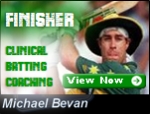|
As young cricketer I remember facing up against a number of talented young quicks trying to break into to the professional game. I distinctly recall listening to coaches talk about getting their front arm high; "reach up to the sky" they would say, and then once they had done that, "...now pull the chain!"
At the time I didn't think anything of it, apart from, what's this chain they're talking about? Why does it have to be up so high. And why is pulling it going to make them any better? If anything I remember thinking that the harder they tried to pull down with their front arm the less control they had.
Over the past few months this idea of "reaching up high" and "pulling down", or "pulling the chain", has cropped up again in a number of different scenarios. So let's clear up the feeling that pushing up and then pulling down with the front arm, adds any pace, or a great deal else to a bowlers armoury for that matter.
To begin, what is the benefit of pushing upwards?
- In simply pushing straight up there is none. Given the range of movement most people hold in their shoulders, chest and back, it will send your head, torso and subsequently your body weight backwards. Not a good start.
- To follow, part of the role of a bowlers front arm is to help with direction and aiming. Pushing upwards is going to be very little help in shifting line from leg to off.
So what about pulling downwards? Surely this up and down motion can't be all bad, can it?
- It's likely that "pulling the chain" is one of the most significant contributors to lateral flexion (or side bend) in your action. Lateral flexion is the primary cause of injury in fast bowlers.
- Just try it out standing still; push your left arm up to the sky, then pull it down fast. What happens? Unless you have an extremely strong and well developed core you will feel yourself beginning to fall to the left. Now imagine doing this whilst moving at high speed, probably without an established base, and still on only one foot when the pulling begins.
- Simply put, short extra cover should look out, because the bowler's follow through is heading their way following the sideways snap of their body at release.
So if this up and down motion doesn't work, what should you quick bowlers do?
Actually its obvious.
Fast bowling is a skill based around straight lines moving back and forth from the target. That's exactly how our arms should move: Pushing forwards and then pulling back.
So rather than reaching for the sky, and putting your arm in a position where simply what goes up must come down. Try pushing forwards towards the target with you front hand and arm. Not only keeping your body weight moving forwards but also allowing you to direct it towards a specific target point.
Having extended forwards, you're now putting yourself in a great position from which you can pull back.
And the benefit of this?
To start, now that your not pulling down, there's dramatically less lateral force being placed on your body. The benefits of this alone are massive, but injury prevention and better balance at delivery can do for now.
Secondly, and more excitingly for some, is added pace. When you pulled down with your front arm, your left shoulder would drop, elevating your right shoulder; something that's of very little benefit. In pulling back with the left arm, the right shoulder gets driven forwards, adding an additional element of forward movement towards the target.
So if you want to find a simple way to improve stability, control and pace, just have a look at your front arm and ask yourself, is it pushing and pulling for you or against you?
Discuss this article with other subscribers
|

.jpg)




.jpg)


